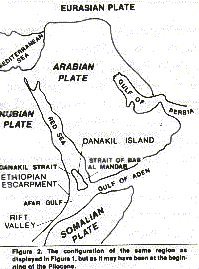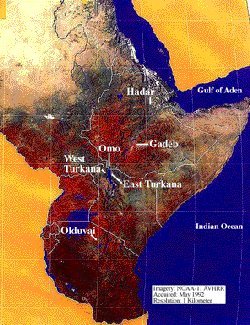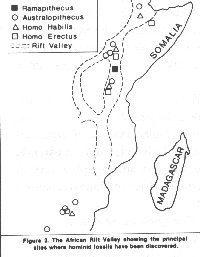Paleoenvironment of Africa: How wet is wet?
Back
Back to Contents
Next
-
Most early hominid fossils like Lucy and the First Family (Australopithecus
afarensis), are found in what were wet environments. In fact, what led Dr. Donald Johanson to
find Lucy in the first place was a knee joint found washed up from a river in Hadar. Lucy
herself was found in sediment layers containing bones of fish and other marine fauna. Moreover,
in 1998 an old proponent of the savanna hypothesis, Prof. Phillip V. Tobias wrote:
"From Hadar, in Ethiopia, where "Lucy" was found, and from Aramis in Ethiopia where Tim White's
team found Ardipithecus ramidus, possibly the oldest hominid fossil found to date, well-wooded
and even forested conditions were inferred from the fauna accompanying the hominid fossils.
All the fossil evidence adds up to the small brained, bipedal hominids of 4 - 2.5 Ma having
lived in a woodland or forest niche, not savanna."
|

Figure 1: Early Pliocene configuration of Northeast Africa (after LaLumierre 1981).
|

Figure 2: Northeast Africa Map showing Fossil Hominid Sites.
|

Figure 3: LaLumierre's Map Showing Hominid Fossil Sites and Rift Valley.
|
|
The Hadar basin has at times been so full as to leave only
islands out of what was mainland.
|
It has been proposed (Verhaegen and Munro 1999) that the groups which led to the modern African
apes, (gorillas and chimpanzees) left the coastal areas in earlier successions than the group
which led to Homo sapiens. They could have migrated inland along rivers through the Rift
Valley. According to Verhaegen, the ancestors of the modern gorillas would have left the
coastal areas first, followed perhaps a few million years later by the ancestors of the
modern chimpanzees (Pan troglodyte, and P. panicus). The last to leave the watery places would
have been our own genus, Homo.
However, this begs the question of Homo: Did he really leave? Or did he remain near the coasts,
lakes and rivers and continue to exploit and adapt to his semi-aquatic existance? If indeed he had
acquired swimming and diving skills, then why abandon a reliable food source? Our speciation occured
as the African continent was becoming more and more dry, and the grasslands were expanding
far and wide, yet hominid remains are all found immediate to (if not in) forested, watery
environments.
There is geologic evidence that for periodic times the Danakil Alps, lying between the
Ethiopian Escarpment and the Arabian plate were isolated as islands, as seen in figure 3
(LaLumierre 1981). Could this island which was periodically reconnected to the African mainland
have been the isolated spot where our ancestors were forced into more aquatic behaviour?
During this time, (late Miocene to mid Pliocene), there many successive rises and falls of sea level
in the area, due to the opening of the Red Sea, uplift and rifting, among other things.
This would allow some of these apes to leave, while others may have remained
once again to be trapped on the island, resulting in geographic isolation and further speciation from
those who went before (La Lumierre 1981).
This reasoning could help to explain all the variaties of hominids, from the Australopithecines to Homo habilis,
H. erectus, H. neanderthalis and finally, Homo sapiens. As previously stated, there were many rises
and falls of sea levels creating islands then reconnecting these islands to the mainlands. There were
literally millions of years for this scenario to replay a few times.
Taking this into account, provides us with an environment which would favour bipedal wading
and walking, eventually resulting in bipedal locomotion as the preferred mode of transport.
In fact, these marginal environments, gallery forests, riversides and coastlines could have
easily been the differentiating factor which led to the genesis of our species. As each successive
species migrated elsewhere, the ancestors of humans may have remained at the shorelines
continuing to exploit the aquatic environment, even as the rest of Africa was drying around them...
Next
Back to Contents
Back


